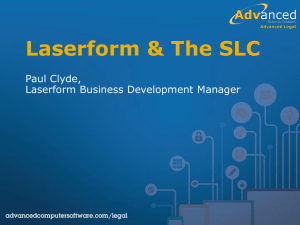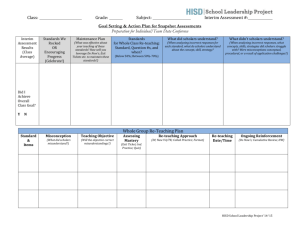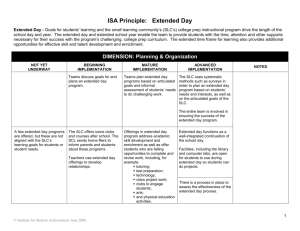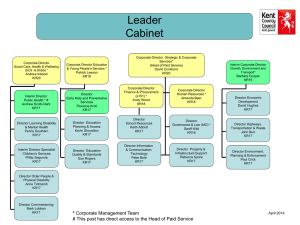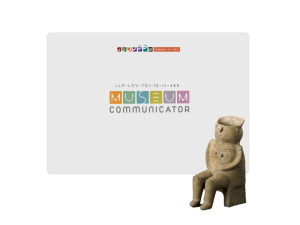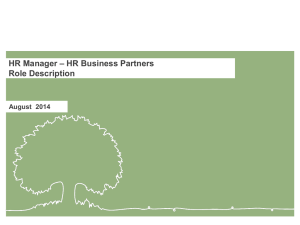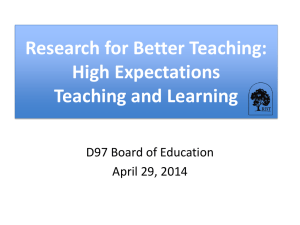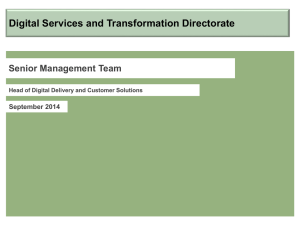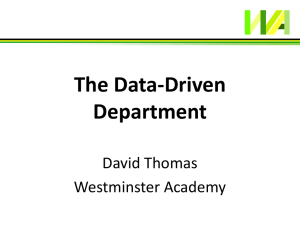CIM Item Analysis Re-Teaching - Dunbar Vocational Career Academy
advertisement
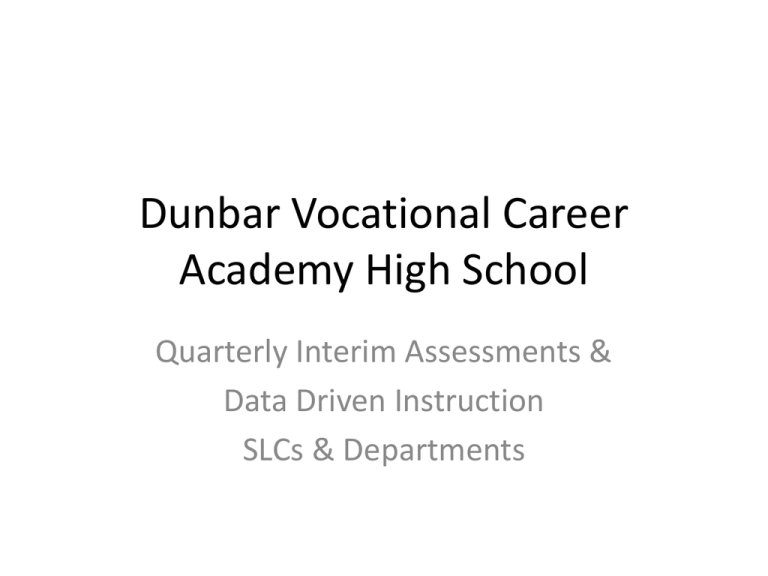
Dunbar Vocational Career Academy High School Quarterly Interim Assessments & Data Driven Instruction SLCs & Departments Essential Questions • What are the data driven instruction protocols? • How do I improve my instruction using assessment data? • How can we leverage Teacher Cooperative Teams (SLCs & Departmens) to improve individual teacher instruction? Objectives Instructors within each SLC & Department will be able to ….. • understand the item analysis process • differentiate between what type of reteaching is needed: whole class, groups, or individual • complete the prediction inventory for the interim assessment (bring to next week’s SLC & Departmental meeting) Implementation Data Driven Instruction (DDI) Protocols: 1. Predicting Task Protocol 2. Test-in-Hand Analysis Protocol 3. Student Reflection Protocol 4. Results Meeting Protocol 5. Re-teaching Lesson Planning Protocol Technology Support: Curriculum Information Management • CIM (Curriculum Information Management) • Part of the IMPACT Suite • Will give you access to student data from your rosters: Standardized exams, interim exams, and YOUR OWN exams • Follow up session Instructional Support • Key Performance Indicator (KPI): Curriculum Alignment to CRS and skills attainment • Choosing readings that are aligned to specific skills (Level 1 and Level 2) Review: Item Analysis • Item Analysis: Looking at HOW students responded & WHAT answers they chose to get insight on your teaching • Helps you determine the quality of the exam • Can be done with multiple choice (CIM, Excel) and rubrics (Rubistar.com) What to Do? Look at Student Groups. Look at the “spreads” of answers: Type of Spread Meaning One strong answer Many students know; others may have a misconception or don’t know Split answer Clear misconception; review answer choices Guessing; cannot conclude instruction was effective Poor distractor Evenly distributed Answer choice not chosen Example: Humanities - Inferring What do we see? None of the answers are over 50% of student selecting the correct answer What might we conclude? • The skill has not been taught (not an exam issue) • Students are guessing (even spread) • Question 24 was more difficult (why?) You Try Look at Prose Fiction – Inferring (3 minutes in your SLC or Department) What to Do? Look at Student Groups. Look at the “spreads” of answers: Type of Spread Meaning One strong answer Split answer Evenly distributed Answer choice not chosen Many students know; others may have a misconception or don’t know Clear misconception; review answer choices Guessing; cannot conclude instruction was effective Poor distractor You Try: Debrief with your Team…. What did you see? About ½ of students consistently replied correctly What might we conclude? • Some students have the skill; others don’t • Question 5 was difficulty (why?) What’s the Next Step? Individually as a part of your Department or SLC: 1. Look at the questions to identify misconceptions and strategies 2. Create a re-teaching (corrective instruction) plan 3. Look to see which students chose which answers 4. Ask the students why they missed the questions I. Look at the Questions Performance on an exam does not tell you WHAT to teach specifically – it just gives you a general area to target…. Example: Humanities - Inferring Looking at the Questions…… • Turn to page 28 and 29 • Look at Q 17, Q 21, Q 24, and Q 25 – What do you see? – What can you conclude? What Do You See? • The text is simple and straightforward • The questions require students to understand SPECIFIC details in the text (evidence) II. What Do I Re-Teach? 1. Students need to understand that even if something does not appear directly in the text, there must be some supporting detail… 2. Students need to ID supporting details and make some type of inference… 3. Students must be able to discriminate between details that actually occur in text and an inference… Who Do I Re-Teach? • Whole Group: Few students show evidence of mastering the skill; provide these students extension activities while re-teaching • Group Instruction: Provide a differentiated assignment, targeting needs of specific groups (usually cannot be beyond 3 things) • Individual Instruction: Create spiraled activities, so students continue to practice as well as pullouts or tutoring Tips for Re-Teaching…. • Be VERY selective • Start as simple as you can and move up Picture books Problems with numbers, then converted to variables One paragraph readings as opposed to an article or text book • Refer to previous assessment and assess at each step On Your Own (20 minutes) • In a group of 3 or 4 select 2 groups of responses from Reading or Math • Complete an item analysis: What do you see in the data? What did you learn from the questions? What would you re-teach? Who would you re-teach? Share Out (15 Minutes) Back to the Beginning • What are the data driven instruction protocols? • How do I improve my instruction using assessment data? • How can we leverage Teacher Cooperative Teams to improve individual teacher instruction? Implementation Data Driven Instruction Protocols: 1. Predicting Task Protocol 2. Test-in-Hand Analysis Protocol 3. Student Reflection Protocol 4. Results Meeting Protocol 5. Re-teaching Lesson Planning Protocol Process: Step 1 - Prediction Task • Developing a “natural” quarterly cycle • Prediction: Look at the exam and predict how students will do (Interim exam) Assignment: Complete the prediction protocol for your students using the interim exam. Bring back to PD next Friday. Process: Step 2 – Test in Hand 1. With your student results, check your predictions 2. Were they accurate? Why (not)? Process: Step 3 – Student Reflection • Have students reflect on their exam performance – don’t just hand back the test • What did I miss? • Why did I miss? • What do I have to understand to move on? What do I specifically need help with? Process: Step 4 - Results Meetings Work with your SLC and your Dept. team asking… • Was our curriculum aligned? Did we touch on the right things or just a lot of things? • Were there some approaches that did better than others? • What revisions do we need to make to curriculum/exams? • How can we support each other? Process: Step 5 – Re-Teaching Plan • Determine WHAT needs to be re-taught • Determine WHO needs to be re-taught Response To Interventions (RTI) & Key Performance Indicators (KPI) Objectives Instructors will be able to…. • understand the item analysis process • differentiate between what type of reteaching is needed: whole class, groups, or individual • complete the prediction inventory for the interim assessment (bring to next week’s SLC and Department meeting)
